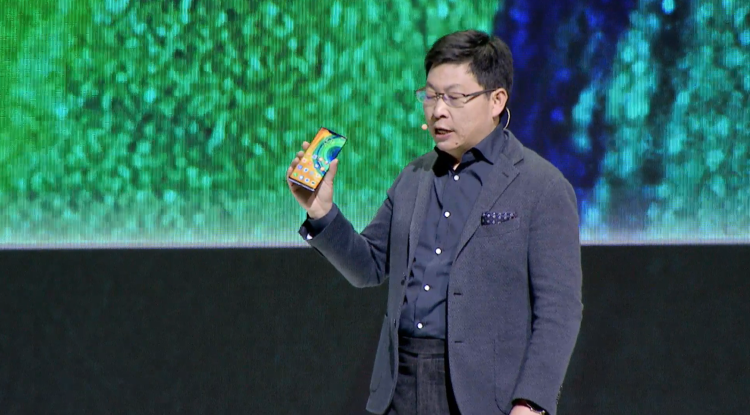It’s a curious time for Huawei, which only weeks ago announced new earbuds as the U.S. contemplated lifting trade restrictions on the company and its subsidiaries. Escalating tensions with China threaten to put the kibosh on easement plans in the near term, and Huawei founder and CEO Ren Zhengfei estimates the resulting lost revenue at $30 billion. But that’s not stopping the Beijing company from forging ahead.
At a press event this morning in Munich, Huawei announced the Mate 30 and Mate 30 Pro. They’re the successors to last year’s Mate 20 and Mate 20 Pro, and they’ve improved in nearly every respect. Among the highlights are a quad rear camera with a 40-megapixel primary sensor and an edge-to-edge display that extends nearly to the phone’s rear cover. Plus, not for nothing, they’re the first to sport Huawei’s new Kirin 990 5G, an all-in-one, full-frequency 5G system-on-chip.
Design
The Mate 30 Pro is distinguished from the Mate 30 mostly by size, as was the case with the Mate 20 and Mate 20 Pro. It’s slightly larger and heavier (198 grams versus 196 grams), and it has a narrow screen notch accommodating the front-facing camera and sensors, as opposed to the Mate 30 Pro’s wider cutout.
Shatter-resistant glass shields the IP68 aluminum that frames the Mate 30 Pro’s 14.4:9 aspect ratio 2400 x 1176 OLED display, which follows 88 degrees around the tapered rims’ contours and extends nearly to the USB-C port, mic, and down-firing speaker. (The Mate 30 has a flat screen by contrast.) It’s DCI-P3 HDR compliant, and it minimizes sleep-interrupting blue light by 25% compared with traditional OLED screens.
June 5th: The AI Audit in NYC
Join us next week in NYC to engage with top executive leaders, delving into strategies for auditing AI models to ensure fairness, optimal performance, and ethical compliance across diverse organizations. Secure your attendance for this exclusive invite-only event.
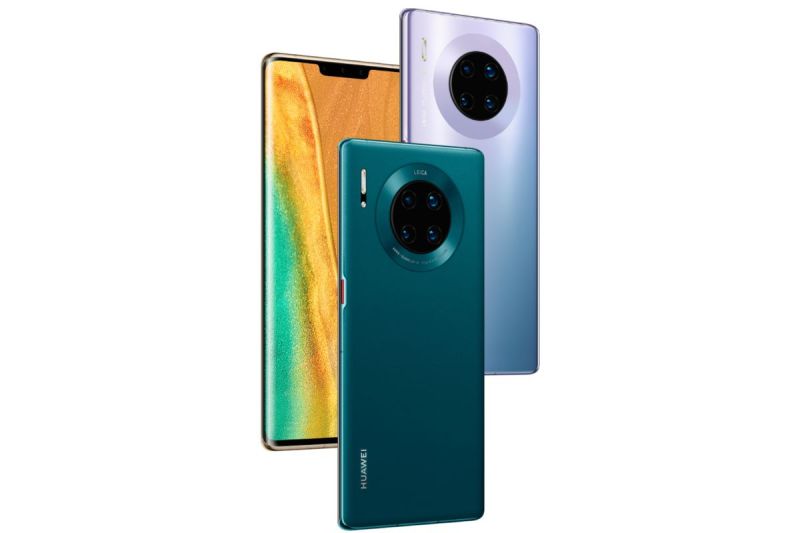
Above: Huawei’s Mate 30 Pro.
There’s nary a physical button in sight on the Mate 30 and Mate 30 Pro, save a power toggle on the right side — volume adjustment is relegated to a double tap of the right or left capacitive sensors. That’s a departure from the Mate 30 series’ predecessors, which had conventional rockers and dedicated shutter buttons.
The upper quartile of the displays vibrate to produce sound, effectively doubling as earpieces. And the button halves conceal embedded optical fingerprint sensors, in contrast to the ultrasonic pair in Samsung’s Galaxy S10, S10+, and Note10. Speaking of displays, the Mate 30 Pro’s measures 6.53 inches diagonally and the Mate 30’s 6.62 inches, compared with the Mate 20 Pro’s 6.53 inches.
Like the Mate 20 series before it, the Mate 30 family dispenses with the 3.5mm headphone jack — a move Huawei asserts is justified by the phones’ larger batteries and 21 MIMO antennas (14 5G antennas alone). As something of a consolation, they get a front-facing camera, a gesture sensor, and a 3D depth sensor, which together enable gesture control.
Flip the Mate 30 Pro around, and you’ll come to what is arguably the star of the show: a quad-sensor circular camera module accented by a patterned ring around its outer border, boasting lenses supplied by longtime Huawei collaborator Leica. It juts out slightly from the phone’s rear and sits adjacent to a dual LED flash module, a laser phase-detection autofocus system, and a depth sensor.
Cameras
The Mate 30 has a 16-megapixel (f/2.2 aperture, 17mm) primary camera that ranges up to 204800 ISO and an upgraded ultra-wide sensor that comes in at 40 megapixels (f/1.8 aperture, 27mm). They complement an 8-megapixel telephoto sensor (with f/2.4 aperture, 80mm) capable of up to 3 times optical zoom and 30 times digital zoom.
As for the Mate 30 Pro, it makes do with a 40-megapixel (f/1.8 aperture, 18mm) primary camera that ranges up to 409600 ISO, and a 40-megapixel ultra-wide sensor (f/1.6 aperture, 27mm) and 8-megapixel telephoto sensor (with f/2.4 aperture, 80mm).
Huawei’s SuperSpectrum tech, which made its debut with the P30 and P30 Pro, is present and accounted for. Basically, it replaces the green filter in the standard red, green, and blue color Bayer filter mosaic atop most photosensor grids with yellow, ostensibly enabling the Mate 30 series’ cameras to take in as much as 40% more light than conventional photosensors. That’s owing to yellow’s wider wavelength, which is about 600 nanometers compared with green’s 550.
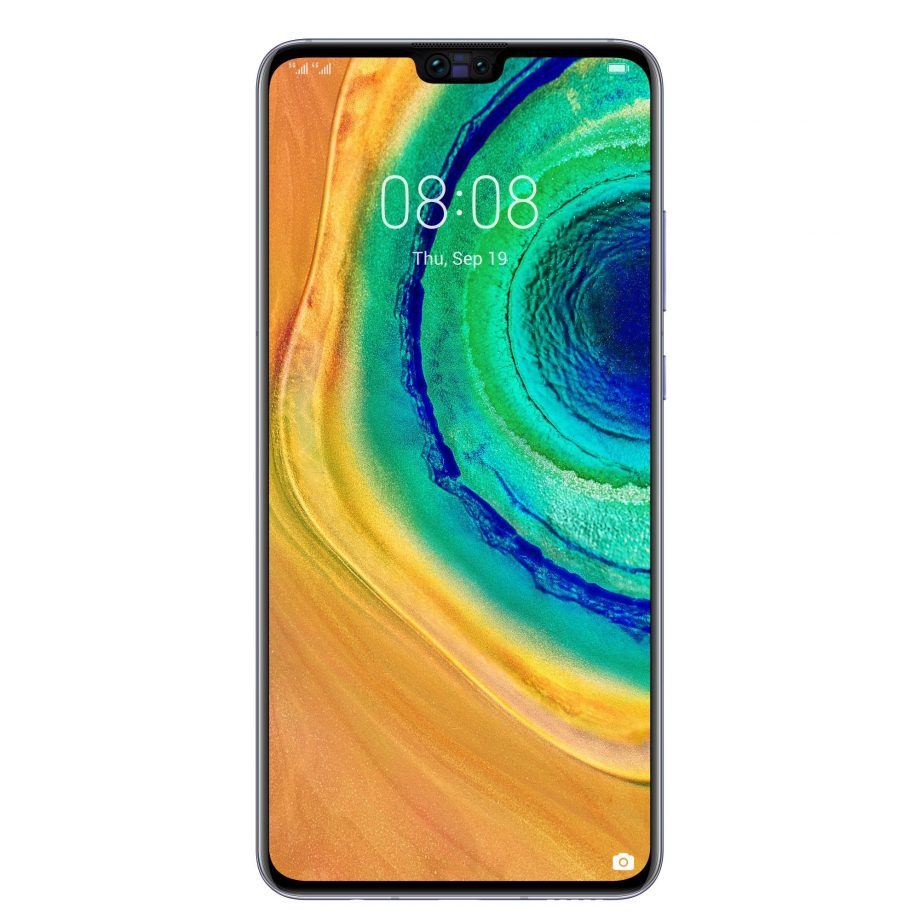
Above: Mate 30
One of the Mate 30 Pro’s headlining photography features is a super slow-motion video recording mode that captures clips at 7,680 frames per second, a ludicrous 8 times slower than rival devices from Samsung, Sony, and others. It’s a software-enhanced version of the Mate 30 Pro’s 960 frames per second recording mode, and Huawei says it employs a wealth of computational techniques to ensure recordings appear just as smooth as they would if they were shot at a sensor-native speed.
At conventional speeds (30 frames per second), Mate 30 series handsets can shoot up to 4K HDR at 30 frames per second with real-time bokeh, benefiting from an AI stabilization algorithm that works in tandem with the main lens’ and zoom lens’ optical image stabilization. The low-light advantages of the yellow filter extend to video capture, as do the enhanced optical and hybrid zoom — videos on the Mate 30 and Mate 30 Pro should appear both brighter and sharper compared with their Mate 20 predecessors.
The sensors on the Mate 30 phones have a leg up in other areas, thanks to Huawei’s sophisticated image post-processing tech. The primary 40-megapixel camera supports point-and-shoot long exposure shots, while the portrait mode squeezes more frames into the composition, bringing out details that would normally be lost — not to mention nuanced bokeh that’s “blurrier” further away from subjects than in the near distance. And an enhanced Night mode composites the best photos of a burst shot taken at multiple exposures, along with AI-assisted stabilization (AIS) and “4D” focus that predicts where subjects are moving to keep them in focus and intelligently crops frames to smooth out jerky footage.
Rounding things out is Master AI, an “intelligent” scene recognizer akin to Samsung’s Scene Optimizer and LG’s AI Cam that adjusts the camera’s settings automatically — depending on ambient lighting, contrast, and other factors. Lastly, a dual-view video mode shows two of the phone’s four camera feeds at the same time in a split-screen view, letting budding cinematographers frame close-up and wide-angle shots simultaneously.
Performance
Huawei historically previews the chipset inside its Mate phones well ahead of their launch, and this year was no exception. The Kirin 990 5G — the chip the company previewed at IFA 2019 in early September — is the beating silicon heart of the Mate 30 series.
The Kirin 990 5G, which — like the Kirin 980 — is manufactured on a 7nm process but with extreme ultraviolet lithography, boasts 10.3 billion transistors in all. (That’s up from 6.9 billion in the Kirin 980 and 5.5 billion in the Kirin 970.) Contributing to the uptick is a refreshed 8-core architecture with two 2.86GHz Cortex-A76 high-performance cores for demanding computation, two 2.36GHz Cortex-A76 “middle cores” that juggle everyday workloads, and four 1.8GHz Cortex-A55 efficiency cores that field light tasks, like music playback and file transfers.
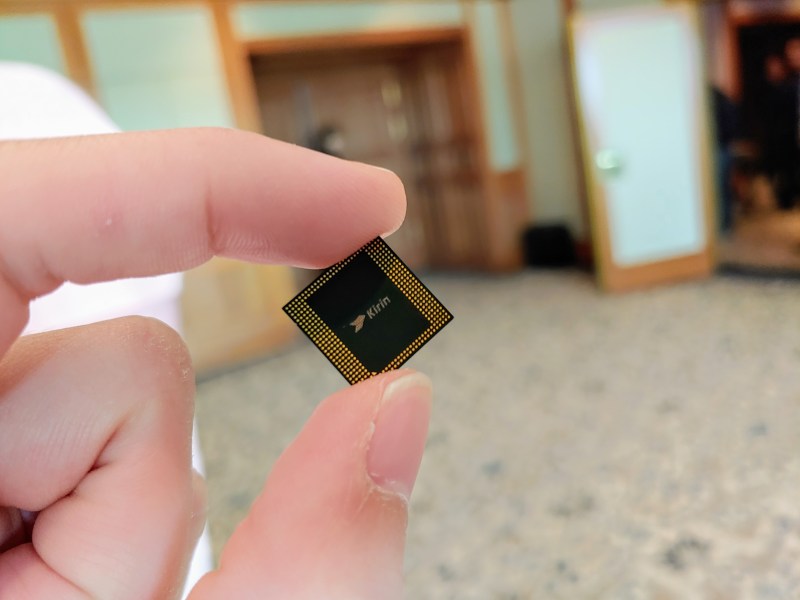
Above: A mock-up of the Kirin 990 5G system-on-chip.
It’s paired with 8GB of RAM in the Mate 30 Pro. Storage capacity maxes out at 256GB, expandable with Huawei’s proprietary NanoMemory storage cards.
There’s a powerful 12-core graphics chip inside the Kirin 990 5G that’s paired with the 8-core processor: the Mali-G76. It packs six more cores than the Mali-G76 in the Kirin 980 and a cache that serves to reduce bandwidth usage and power draw. These and other improvements enable the new Mali-G76 to leapfrog the Snapdragon 855’s Adreno 640 chip, according to Huawei, by 6% in terms of overall performance and 20% in efficiency.
Huawei’s Neural Processing Unit (NPU) made its first appearance at IFA 2017, where it debuted in the Kirin 970. Boiled down to basics, it’s a coprocessor optimized for the sort of vector math that’s the lifeblood of machine learning algorithms. Qualcomm’s AI Engine and Samsung’s own Neural Processing Unit achieve the same ends through different means, but Huawei claims its homegrown Da Vinci architecture is far and away the most capable. To this end, it delivers tensor computation under half-precision FP16 and INT8 data types courtesy of two “big” cores for high-intensity workloads and one “tiny” core for less-intensive computation. A single tiny core is up to 24 times more efficient than a big core for tasks like facial recognition, according to Huawei.
It’s all cooled by a graphene film that Huawei says keeps the Mate 30 and Mate 30 Pro 3.9 degrees Celsius cooler than competitors.
5G
The Kirin 990 5G will be one of the first all-in-one, full-frequency 5G chipsets to market later this year, on a die area that’s roughly 36% smaller than rival products demonstrated to date. It supports four sub-6Hz antennas in total and both non-standalone (NSA) and standalone (SA) architectures, as well as TDD/FDD full frequency bands, but not millimeter-wave.
The chip’s performance won’t disappoint if benchmark results are to be believed. Huawei claims the Kirin 990 5G’s machine learning-based adaptive receiver and split uplink design boosts download and upload speeds in “high-movement” weak-signal environments like cars, train stations, and busses, delivering up to 5.8 times the max upload speed of leading chipsets in preliminary testing. In spots with stronger signals, it’s theoretically capable of reaching downlink and uplink rates of up to 2.3Gbps and 1.25Gbps, respectively.
Only the pricier of the two available Mate 30 Pro models ships with a 5G modem, it’s worth noting. The Mate 30 is a strictly 4G affair.
Battery life and charging
The Mate 30 series might have system-in-chips in common, but the batteries are another story. The Mate 30 Pro’s is 4,500mAh in capacity (up slightly from the Mate 20 Pro’s 4,200mAh) versus the Mate 30’s 4,200mAh (up from 4,000mAh), and Huawei says they’ll last for 9.2 hours and 8.2 hours, respectively.
Both support Huawei’s 40-watt SuperCharge technology, which can deliver up to 70% power in half an hour. On the wireless charging side of the equation, all three Mate 30 series phones wirelessly charge at up to 27 watts and reverse wirelessly charge any Qi-compatible gadget from their rear covers. Reverse wireless charging isn’t anything new for Huawei, but this iteration is slightly more powerful than previous generations.
Software
The Mate 30 and Mate 30 Pro ship running Emotion UI (EMUI), Huawei’s custom skin atop Android 10. However, as result of the U.S. government’s executive order preventing Huawei from procuring “hardware, software, and technical services” from U.S.-affiliated companies, it’s expected to be Android Open Source Project (AOSP), a restricted version of Android that doesn’t offer access to Google apps and services (like the Google Play Store, Google Assistant, Gmail, Google Photos, YouTube, Google Maps, Google Drive, and Google Duo) out of the box.
“We cannot use the Google Mobile Services core — we can use the Huawei Mobile Services (HMS) core,” said Richard Yu, CEO of Huawei’s consumer division, onstage. “[That’s] because of a U.S. ban that these phones cannot preinstall the GMS core. It has forced us to use the HMS Core running the Huawei app gallery on the Mate 30 series phones.”
We’ve reached out to Huawei for confirmation, and to clarify whether it’ll offer a workaround. Reuters reported earlier this year that Huawei would offer “its own interface” that will allow users to access some Google apps, but it’s not clear how that might work.
Like the latest publicly available version of EMUI (EMUI 9.0), this new EMUI is chock-full of features with varying degrees of usefulness, most of which Android purists can disable, ignore, or replace without inordinate hassle. One is a custom home screen launcher that lacks an app drawer on the default configuration; another is the use of SwiftKey as the stock keyboard, as opposed to Android’s system keyboard or Google’s Gboard. Also along for the ride are a low-power ambient display mode and system-wide dark mode and a “dark mode engine” that inverts the colors of third-party apps.
Also new? A nifty AI auto-rotate feature that follows your gaze to rotate on-screen content in your direction. It joins “multi-screen collaboration,” which lets you sync text, photos, texts, files, and more to a compatible PC.
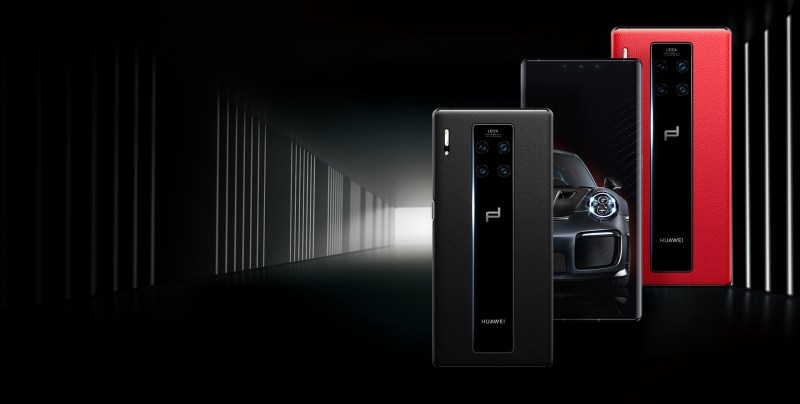
There’s a raise-to-wake function, plus a split-screen view with a versatile screenshot-snipping tool. As with the P30 series, the notch’s appearance is customizable through software — to a degree. You’re able to “mask” it by blacking out the notification shade. And face unlock is present and accounted for, as is support for swipe and knuckle gesture shortcuts; Private Space, which lets you create a secondary device profile linked to an alternative fingerprint; and a suite of utilities, including a voice recorder, QR code reader, flashlight, and calculator.
Finally, if you’re an Audi owner, you’ll be pleased to hear that the Mate 30 and Mate 30 Pro double as digital car keys — Huawei has teamed up with the automaker to preload an app that unlocks your car (Connect Key) on both phones.
Huawei Assistant
The Mate 30 and Mate 30 Pro are also the first to launch with Huawei’s homegrown AI assistant, powered by the company’s Ability Gallery: Huawei Assistant. It’s akin to Google Assistant and can be accessed by swiping to the right of the home screen.
Huawei Assistant features a news feed with custom recommendations and content from selected publishers, along with a search feature that lets users quickly surface installed apps, memos, emails, and calendar entries. Instant Access provides four shortcuts to apps that in the future will be intelligently chosen based on context, and SmarterCare provides real-time information, such as weather forecasts, missed calls, and schedule reminders.
Huawei says that Huawei Assistant might eventually do things like book restaurants, flights, taxis, and hotels.
Huawei Mate 30 Porsche Design RS
As in years past, Huawei has teamed up with Porsche for a special edition of the Mate 30 Pro. The aesthetics are a tad different — the Huawei Mate 30 Porsche Design RS has a long vertical stripe on the back that houses the camera module at the top, and it’s covered in black leather. It also bumps up the RAM to 12GB and storage capacity to 512GB but otherwise packs the same internals as the Mate 30 Pro.
Pricing and availability
Here’s how the Mate 30 series pricing breaks down:
- Mate 30 Pro 8GB RAM and 256GB storage: €1,199 ($1,325.67)
- Mate 30 Pro 8GB RAM and 256GB storage (4G): €1,099 ($1,215.24)
- Mate 30 8GB RAM and 128GB storage (4G): €799 ($883.41)
Availability details have yet to be announced.
The phones come in black, silver, purple, and green gloss, the latter featuring a matte gradient finish with an anti-slip surface. A “vegan leather” option ships in forest green and orange.
